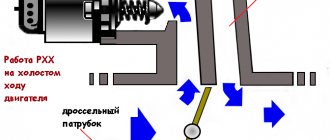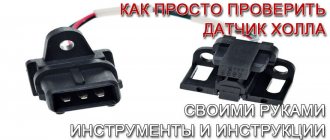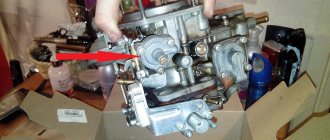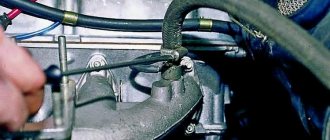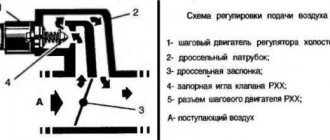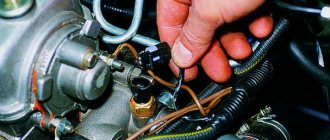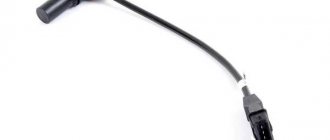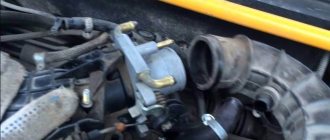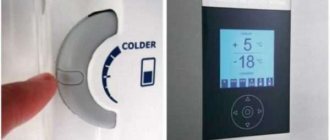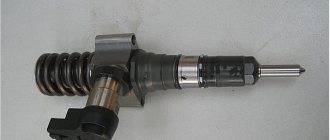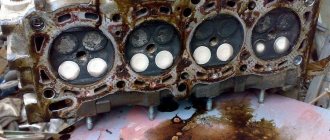Idle speed sensor "Volkswagen Passat B3"
The idle speed sensor in the design of the Volkswagen Passat B3 is responsible for the stability of the power unit in idle mode (hence the name).
That is, in those moments when the driver starts the engine to warm up or during minutes of stops without turning off the engine, it is this sensor that ensures the smoothness and stability of revolutions. Technically speaking, the idle speed sensor on Passat models cannot be considered a sensor in the usual sense of the term. DXX is a performance device that regulates the supply of fresh air, and does not work on collecting and transmitting data, like a standard sensor. Therefore, almost all Volkswagen Passat B3 drivers call this device the idle air control (IAC).
The idle speed of the engine is controlled by the idle speed sensor, otherwise called the regulator.
In Passat B3 cars, the idle speed sensor is located in the engine compartment. The sensor housing is secured with two screws to the throttle body. This position next to the engine is due to the fact that the IAC must regulate the air supply as accurately as possible to create a fuel-air mixture, and the easiest way to do this is directly next to the engine.
Thus, the main task of the IAC is to regulate the air supply at idle so that the engine receives the necessary resources to operate at low speeds.
The sensor is replaced on the engine housing
IAC device
The design of the idle air control on Volkswagen Passat cars is based on one basic element - a stepper motor. It performs an important function - it moves the actuator to the distance that is currently necessary to perform the job efficiently.
In addition to the motor (electric motor), the following are installed in the IAC housing:
- movable rod;
- spring element;
- gaskets;
- needle (or valve).
That is, the motor moves the rod, at the end of which there is a needle. The needle can close, block or further open the throttle valve. Actually, this determines the required amount of air for the engine to operate.
The IAC contains only a few parts, but their incorrect installation or neglect of the distances between them makes the device unsuitable for operation.
The service life of the idle air control valve is usually determined by the vehicle manufacturer. In the case of the latest Volkswagen Passat models, this value is equal to 200 thousand kilometers. However, there are often cases when, for a number of reasons, the IAC failed much earlier than the period specified in the manual.
Engine with single injection
Since 1988, every Volkswagen Passat equipped with a mono-injection engine has been equipped with an idle air regulator of the type VAG No. 051 133 031.
Single injection is a system in which the throttle valve plays the main role. It is this element that is designed to collect and dose air before supplying it to the combustion chamber. And the VAG idle speed sensor No. 051 133 031 should monitor this process. Accordingly, if the sensor breaks down on engines with single injection, the driver will not feel serious inconvenience, since the damper will still function normally.
On older versions of the Volkswagen Passat B3, large-sized monitoring devices were installed
Engine with injector
Things are a little different with Volkswagen Passat engines running on an injector. The IAC is fixed on the throttle valve, which generally “manages” the operation of this mechanism. That is, if the sensor fails, then problems with idling and high engine speeds immediately begin.
More modern versions of the Volkswagen Passat B3, running on injection engines, are equipped with a cylindrical IAC
Video: operating principle of IAC
Idle speed regulator from ZMZ 406, instead of Bosch 0280140512
, publication date March 27, 2020
We present to your attention a controller for replacing the 2-pin Bosch idle air regulator type 0280140512 (and 516) or VDO, which are found in many places on VAGs, Opels, etc. Today (03/27/16) the cost of the idle air regulator in stores ~9200 rubles, we offer you an alternative almost half the price, for 4700 rubles. (complete kit for installing controller + IAC) controller for a 3-pin regulator from ZMZ 406. Since its input-output is located not at an angle of 90, but at 180 degrees, a set of adapter pipes is included in the kit. In the photo you can see what the kit consists of and an example of installation on the AAR at the end of the material. No adjustment is required after installation. The controller has 3 wires, +12V power supply, signal and common. The power and signal are connected to the standard IAC chip, the common one is connected to the terminal on the motor.
A failed regulator means problems with idle. The reasons are natural wear and tear of the regulator mechanics, dirt, or the result of careless cleaning. Idle values can be either high or low. The defect may not appear consistently. Chinese cheap substitutes usually do not work correctly. The main idea of installing the kit is to reduce the cost of replacing the regulator and further maintenance of the car. In addition, the Volga regulator is not susceptible to changes in temperature and on-board voltage. If it fails, a new regulator costs 2,000 rubles in any Volga store versus more than 9,000 for a Bosch.
You can purchase only the controller and everything else yourself, or a kit that includes everything you need for installation. An order can be made on a special page.
Unfortunately, diagnosing a native RRH is very labor-intensive and requires special equipment in order to understand whether the unit needs to be changed or not. Therefore, the problem is usually found out by replacing it with a new one (or removing it from another car) and observing changes in the operation of the engine, whether it has become better or worse. Sometimes you can feel the curtains jamming, which indicates the need to replace the unit.
At the moment, the controller can be installed on Audi engines: DS, NP, NF, AAD, ABK, AAR, 3B, NG, ACE, ABY, ADU, 3A, 6A, 7A, AAN, RR. Engines: VolksWagen - 9A, ABV, AAA. In the future, as diagnostics progress, the list of car brands and engines will expand for Opel, Alfa Romeo, Chevrolet, Citroen, Fiat, Peugeot, Renault and Volvo (cars that use the BOSCH idle air regulator 0280140512 and 0280140516).
You can purchase only the controller and everything else yourself, or a kit that includes everything you need for installation. One year warranty on controller and kit.
Photo of a kit for replacing the original idle air control (IAC) Bosch 0280140512 with an IAC from ZMZ 406
Photo with installed controller and IAC from ZMZ 406 on Audi AAR.
Thank you all so much for spreading the information about this upgrade.
The kits have been installed and successfully tested on the following cars:
- 01. Audi 100 C4 with an AAR engine, already driven several times.
- 02. VolksWagen 2E and PF, special firmware for these engines has been tested.
- 03. Successfully tested on MB124. Regulator number 0 280 140 510.
- 04. Tested the firmware for Mercedes-Benz with 119.960 KE-Jetronic engines, regulator
Attention, on VolksWagen engines: 9A, Audi: AAD, ACE and 3A, all Mercedes-Benz engines: 102, 103, ... it is necessary to leave the standard regulator as a load. Otherwise the ECU will fail. The standard regulator can be placed anywhere (even in the trunk), the main thing is to connect the wires.
Problems with idle speed sensors (IAC) on the Volkswagen Passat B3
What can result from incorrect operation of the IAC or device failure? The complexity of this problem lies in the fact that if the IAC breaks down, then the driver does not receive a signal to the control panel (as other sensors do). That is, the driver can find out about a breakdown only by the signs that he himself notices while driving:
- the engine idles with jerks and interruptions, that is, the speed “floats” all the time;
- If you turn off the gear while idling, the engine will stall;
- at the moment of starting the engine “cold” there is no increase in speed for prompt warming up;
- If you turn on the heater, lights or air conditioner at idle, the number of engine revolutions will immediately decrease.
The performance of the IAC may be affected by adhering dirt, liquid leaks and other unfavorable conditions.
A large number of drivers are interested in the question: what are the causes of all these problems, why does the IAC fail before the stated time? The main reason for incorrect operation lies both in the wiring of the device and in severe wear of the sensor rod or spring. And if the problem with the wires is solved quickly (during a visual inspection), then it is almost impossible to determine damage to the housing.
In this regard, the idle speed controller on the Volkswagen Passat is difficult to repair. Repair work can be performed, but there is no guarantee that the device will be assembled correctly, since the position of each element is strictly defined. Therefore, in case of any problems with speed, it is recommended to immediately replace this device.
How to extend the life of the idle speed sensor
Service specialists recommend that Volkswagen Passat B3 owners follow simple rules to maximize the service life of the IAC:
- Replace the air filter in a timely manner.
- When parked for long periods in winter, periodically warm up the engine to prevent the IAC from sticking.
- Make sure that foreign liquids do not get on the idle speed sensor housing or on the throttle valve.
These simple tips will help to avoid rapid wear of the sensor mechanisms and extend its service life to the 200 thousand kilometers declared by the manufacturer.
Careful attention to all systems of your car can significantly extend its service life.
Replacing the idle speed sensor yourself
If there is a malfunction in the operation of the IAC, it will be necessary to replace it. This procedure is simple, so there is no point in contacting service station specialists.
IAC is not cheap. Depending on the year of manufacture of the Volkswagen Passat and engine size, the device can cost from 3,200 to 5,800 rubles.
German spare parts are especially popular among car owners due to their quality and reliability.
To perform the replacement you will need:
- open-end wrench 10;
- flat screwdriver;
- new idle speed sensor.
Operating procedure
It is best to dismantle the IAC with a cold engine: this way there will be no risk of getting burned. The process of removing the old sensor and installing a new one takes several steps:
- Remove the negative terminal from the battery.
- Disconnect the cable harness from the IAC housing.
- Unscrew the sensor mounting screws.
- Pull the sensor itself out of the mounting socket.
- Clean the joint area from adhering dirt and dust.
- Install a new IAC into the vacated slot and tighten the screws.
- The main task when installing the IAC is to ensure a distance of 23 mm from the sensor needle to the mounting flange.
- Connect a cable to it.
- Return the negative wire to the battery terminal.
Photo gallery: DIY IAC replacement
The negative wire from the battery must be disconnected immediately. First, you need to remove the wires from the sensor, then unscrew it from the mounting socket. The new device must be fixed in a cleaned place. Connect the cable cable to the new IAC, fix it to the flange with screws.
Immediately after replacement, it is recommended to start the engine and check that the work is being done correctly. If the engine idles smoothly, then the new IAC was installed correctly. For your own peace of mind, you can turn on the headlights and air conditioning at the same time - the speed should not “drop”.
Idle speed adjustment
Quite often, the idle speed sensor can be “capricious” for the reason that the initial parameters of its operation have gone astray. In these cases, you can adjust the idle speed. The main element of this work will be the IAC.
The adjustment procedure should be performed according to the algorithm:
- There is an adjusting screw on the engine throttle valve.
- If the engine speed jumps a lot when the car is idling, you need to slightly unscrew this screw towards yourself (no more than 0.5 turns).
- If the speed is consistently low, insufficient, then you need to screw the adjusting screw into the damper.
- It is important to measure the distance between the IAC needle and the flange: it should not exceed 23 mm.
Video: detailed instructions for adjusting idle speed
I suffered for three years myself. It's simple. There is a bolt on the throttle. If the revs jump, then turn it up a little. If the revs stick, tighten it up. It may still get lost over time. Also, be sure to check all vacuum tubes for cracks. air can pass through
Thus, it will not be possible to repair the idle speed control yourself: it is much easier and faster (although more expensive) to replace it with a new one. If necessary, you can always adjust the operation of the idle speed systems: if you do it yourself, it will take some time to understand exactly what number of revolutions it is better to unscrew the screw.
Reducing the speed: idle speed control of the Audi 80 engine
Updated: 2018-01-04 Author: audi39 Number of comments: 2
Many owners complain that the car may suddenly stall or start accelerating when the pedal is not pressed. When the gas is low it starts to jerk. When warming up, the idle speed drops to 300-400, the car may stall completely, but after a certain time it will work normally. This may not happen again, or may suddenly cause confusion when driving on the road. In summer, difficulties do not arise - there is no need to warm up the engine, but in cold weather the speed may drop if the car is just sitting in a traffic jam. There are other similar problems. Looking at the diagnostic stand, you can see misfires and increased CH. Symptoms appear from a malfunctioning idle speed sensor. It is a small black box with a mono-injection. The problem can be solved by replacing this regulator with a new one. But not for long. In a few months everything will resume. Therefore, it is better to take a multimeter, a set of screwdrivers and repair the rcx.
Volkswagen Passat › Logbook › rxx repair
In short, troubles began with Monique. There are no warm-up rooms. on hot xx floats. and the main problem appeared on the 1st. you press the gas. and the engine runs as if the ignition is on. then off spins up to about 1100-1200 and to an almost complete stop. and so on at fairly rapid intervals. as magnum87 rightly noted, the symptoms are similar to the pxx limit switch. and he was partly, or maybe completely, right. I removed the rcx and checked the limit switch. turned out to be a bad contact. you had to press hard for it to work. sorted it out. cleaned it. it was a little burnt. After cleaning, the limit switch began to operate when lightly pressed. tortured him many times. there were no misfires) and that’s what I noticed. The pin presses onto the contacts of the limit switch. which is inside. I'm sure problems can arise due to its deformation. over time, when pressed, it will not come out enough and put bad pressure on the metal plate of the limit switch and, accordingly, there will be poor contact. As I understand it, the limit switch button is screwed onto the gear along the thread. and with this thread you can adjust the force of pressing this pin on the contacts of the limit switch. so to speak, adjust the pressure sensitivity. This will remove the free play that is on the end switch. I couldn't unscrew it. because this contact rod is a limit switch. or whatever it's called. with a spring which. It's somehow sealed onto the gear thread. In general, I didn’t bother. I was afraid to break it. I'll get to that another time. wrote about it. because it may very well be useful to someone. I’ll write about the results of my work tomorrow. It's dark already. I do it outside. So I’m postponing the installation of pxx until tomorrow. I’ll post in the same thread) magnum87 thanks for the tip)
Rxx repair
Many people advise simply disassembling the Audi 80 idle speed sensor, cleaning the contacts and putting it back together.
Don't forget to remember the position of the plates and return everything to its place when reassembling.
We clean them with fine sandpaper and wipe them with alcohol or graphite lubricant. This will help for a week, maximum for a month. The real reason for the malfunction lies elsewhere. To begin, carefully disassemble the structure. The body is held together with latches. Because The case is plastic, but over time it becomes inelastic and the latches are easy to break. Nothing bad will happen if you break them off; for reliability, everything is secured with screws. But it’s better to keep everything intact. Inside the xx Audi 80 regulator, at the end of the rod there is a pusher with a spring. By pressing the elastic plates in the rod, the pusher closes them together. And in the middle of the pusher there is a rod that deforms under constant load. The rod is shortened and does not reach the plates. This is very easy to fix. The pusher is attached to the rod using a thread. We tighten the thread until the distance between the pusher and the plates is restored and the signal no longer disappears. Problem solved. Without a tool, it will not be easy to tighten the thread, so we take pliers and carefully wrap the rolled thread.
Useful article: Carburetor: which one can be installed on an Audi 80?
